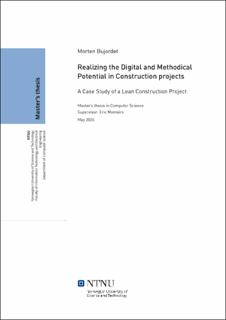| dc.contributor.advisor | Monteiro, Eric | |
| dc.contributor.author | Bujordet, Morten | |
| dc.date.accessioned | 2021-09-15T16:11:21Z | |
| dc.date.available | 2021-09-15T16:11:21Z | |
| dc.date.issued | 2020 | |
| dc.identifier | no.ntnu:inspera:57320302:25626126 | |
| dc.identifier.uri | https://hdl.handle.net/11250/2777803 | |
| dc.description.abstract | En bekymring for bygg- og anleggsvirksomheter i Norge er den betydelige nedgangen i arbeidsproduktivitet sammenlignet med andre Fastland industrier. Statistikk viser en relativ forskjell i arbeidsproduktivitet, sammenlignet med IKT-industrien fra år 2000 og fram til 2016, på 106,4 %. Forskningen identifiserer en industri som bruker gamle metoder, men som bruker ny teknologi. Endringen i teknologi forårsaker nye roller og mer komplekse konstruksjoner - denne endringen har ført til en innføring smidig metoder og ulike programvarer som støtter disse metodene. Denne studien skal se på byggingen av det nye Livsvitenskapsbygget, ved Universitetet i Oslo, for å utforske betingelsene for norske byggeprosjekter, som bruker både Lean og BIM, for å oppnå potensialet i både anvendt metodikk og digitale verktøy.
Ved bruk av semistrukturerte intervjuer og observasjoner, med deltakere fra alle fagfelt fra prosjektorganisasjonen, identifiserte en tematisk analyse av intervjuene to viktige problemer: (1) overlappende programvare funksjonalitet og bruk, og (2) mangel på grunnleggende metodisk kunnskap. Forskningen identifiserte en utfordring med bruk av forskjellig programvare i prosjektet, noe som gjorde at aktørene brukte andre verktøy - derav problemet med overlappende verktøy. Videre utnytter ikke prosjektet potensialet til anvendt BIM-teknologi.
Basert på disse observasjonene foreslår prosjektet to nye initiativer for bedre utnyttelse av Lean og anvendt programvare i byggebransjen. For det første trengs ny forskning for å finne en metode for å skrive oppgavebeskrivelser som brukes i Lean Design-prosessen. Undersøk dessuten behovet for et slikt rammeverk i Lean Bygging. For det andre er det behov for mer forskning når det gjelder bruk av sky-tjenester i BIM-modellering. | |
| dc.description.abstract | A primary concern of the construction industry in Norway is the significant decline in labor productivity compared to other on-land industries. Statistics show a relative difference in labor productivity, compared to the ICT industry from the year 2000 up to 2016, of 106.4%. The research identifies an industry utilizing old methods, with the use of new technology. The change in technology is causing new roles and more complex constructions—this change made for utilizing agile management and software supporting these methods. This case study looks at the new life science building project, of the University of Oslo, to explore the primary conditions for Norwegian construction projects, utilizing Lean and BIM, to achieve the potential of both the applied methodology and digital tools.
Using semi-structured interviews and observations, with participants from all disciplines from the project organization, a thematic analysis of the interviews identified two key problems: (1) Overlapping Software Functionality and Software Usage and (2) Lack of Fundamental Methodological Knowledge. The research identified a challenge with the use of different software in the project, making the actors using other tools - hence, the problem of overlapping tools. Furthermore, the project does not utilize the potential of applied BIM technology.
Based on these observations, the project proposes two new initiatives for better the utilization of Lean and applied software in the construction industry. First, new research is needed to find a method of writing task descriptions used in the Lean Design process. Moreover, investigate the need for such a framework in Lean Construction. Second, more research is needed in using cloud computing in BIM modeling. | |
| dc.language | | |
| dc.publisher | NTNU | |
| dc.title | Realizing the Digital and Methodical Potential in Construction projects: A Case Study of a Lean Construction Project | |
| dc.type | Master thesis | |
